The Martial Arts has become synonymous with self defense. This is something that has been engrained in us at least since I was a kid. Even as a kid, I remember when I earned my Tae Kwon Do Black belt at the age of 12, people would say, “Man, I don’t want to mess with you!” But martial arts training doesn’t necessarily mean that you can defend yourself.
Let me explain with a story. At the age of 14, I was playing basketball with some neighborhood kids in a friend’s driveway. There was a kid who wasn’t well-liked that came around and stole our basketball. He probably just wanted to play but didn’t have the social skills to ask. Either way, I felt confident to get our ball back because I had earned my black belt a couple of years before. I told the kid to give me the ball. He dropped the ball and came toward me. I threw a few round kicks at him but didn’t land them. We grabbed each other and pushed and shoved, and eventually ended up on the ground. The other guys broke it up. Later that evening, my dad came home and asked what happened. I said, “Dad, fighting isn’t at all like sparring in my Tae Kwon Do class!”
The point I’m making is that the skills you learn in martial arts are the same as self defense but there’s so much more to self defense than techniques. Most martial arts training consist of learning a plethora of techniques. We even use some of these techniques in a ‘game’ to work timing and distance. This gets us closer to being able to defend ourselves, but there’s much more to it.
While typing this, I realize that many of you may say, “ I train martial arts for other reasons like fitness, camaraderie, confidence, etc.” I get it, me too. But wouldn’t it be nice to know you could use those to protect yourself and your loved ones.
Now, let’s move on and talk about what is different about martial arts training and self defense training.
Self defense training should include simple but effective techniques that do NOT require much skill to learn. These techniques should work 90% of the time and on 90% of people. It should include pre- and post- conflict training. This includes de-escalation, understanding the ‘use of force’ continuum, when and why to call 911, etc. It should include the use of self defense tools like pepper spray, stun guns, knife, and firearms. This should include how to defend against the weapons as well. Furthermore, Self defense training should include a multitude of ranges. This means all the ranges that one could find themselves in. This includes firearms distance, which could mean as far a a firearm could shoot, to striking range(punching and kicking), grappling/wrestling, and on the ground. Don’t forget walls, cars, and other objects will be all around.
So how is martial arts different?
Well, most martial arts training includes the first aspect of self defense training. It teaches basic and effective techniques to defend yourself. However, very quickly, it moves on to more complex and complicated techniques that you will rarely find in self defense situations. For example, spinning kicks, small joint manipulations, and flying armbars. Also, many martial arts include some sort of sparring, which is great. Unfortunately, it generally is only against people who train like you. For example, strikers only fight strikers, and wrestlers only wrestler against wrestlers. This is great to work your techniques but rarely give you a complete picture of a self defense encounter.
Where does the Circle of Life fit into this?
As I said in the beginning, Martial arts is synonymous with Self Defense. If you start training for the sole purpose of protecting yourself and others, you will eventually learn techniques like flying armbars, but that doesn’t mean you are not training for self defense. It just means that you were probably getting bored doing palm strikes and eye gouges or even shooting at a paper target. Just remember the original reason why you started training. If your martial arts training doesn’t include at least some of the previous self defense training, you’re not training for self defense. You are, at best, learning a few techniques that look like self defense.
Martial arts and self defense training demands constant practice. Remember what the Greek poet Archilochus said, “We don’t rise to the level of our expectations; we fall to the level of our training.”
I hope this shed some light on the circle of martial arts and self defense training. If you would like to start training or get back into it, check us out at LoneStarKarate.com.
Shawn Vicknair

